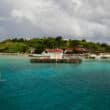Caribbean Design: Steve Fox on Outdoor Living in the Caribbean
By Steve Fox
CJ Contributor
ONE OF the first questions we ask a new client when embarking on the design process is: do you want to use air conditioning in your new home? For some, there’s no debate; the house will be a sealed box, and the temperature must be controlled at all times. However, more typically, the answer is not so straightforward, and it’s necessary to spend some time considering the pros and cons before coming to any conclusions.
Take a quick look at any of the glossy magazines which specialize in Caribbean living and it’s clear that there’s generally a commonly held notion of an ideal kind of island lifestyle: open to the light, breezes and views, tall lofty “Great Rooms” with exposed wood ceilings, an easy flow from inside spaces to outside areas, blurred boundaries between inside and outside, with decks and verandahs as important external living spaces.
This kind of outdoor living is not easy to achieve in Europe and North America, where houses need to be sealed, to protect from the cold. But here in the tropics, it’s not a romantic fantasy; a well-designed house can be left open throughout the day and night, and as a consequence it can feel very spacious, light, airy and relaxed.
So of course, the decision on whether or not to use air conditioning is critical.
The introduction of AC means that rooms have to be sealed, to maintain a controlled environment. Opening of doors and windows needs to be kept to a minimum. If there’s any air leakage, the equipment needs to work harder.
It’s a whole other way of looking at Caribbean living; no more free-flowing inside-outside spaces.
When designing properties for rental, we’re often informed that visitors (particularly visitors from the United States) expect to have air conditioning; it’s an absolute requirement, which can put a completely different spin on a design approach, and can potentially (and ironically) kill off that ideal romantic lifestyle!
We’re not rigidly opposed to the use of AC in homes, but we’re conscious of the negative aspects. AC equipment is expensive to buy, install and maintain.
And running costs are amongst the highest of all household appliances, right up there with electric ovens and dishwashers. Given the very high cost of electricity in the BVI (and not to mention global warming!), it makes sense to try to minimize usage, or eliminate it altogether.
Some owners consider installing renewable solar or wind energy systems to generate their own power, but the power requirements of AC equipment are generally too high to be operated by the average renewable system; a typical photovoltaic array will generally only cover the more manageable household loads.
A well-designed, naturally ventilated house can provide as much, if not more, comfort than an air-conditioned one.
Although air conditioning can allow a high degree of temperature and humidity control on the inside of the home, it creates a separation from the outside, and a large temperature differential; the difference between in and out becomes exaggerated and uncomfortable.
So it makes sense to develop the design to negate the need for air conditioning. A naturally ventilated home which picks up breezes and is well shaded, with attention paid to good window and door placement, and materials which discourage heat buildup, should result in a cool, balanced environment where AC is not needed.
Air flow and shading can be improved through the use of internal courtyards and planting.
With this kind of well thought-through and imaginative design, the connection to the outdoors and to the natural surroundings is celebrated, with fresh air, breezes, good light and views.
The relationship to the site and the landscape is harmonious, the running costs are lower, the atmosphere is healthier, and damage to the environment is reduced. Part of our job as architects is to challenge assumptions, and the general reliance on air conditioning in hot climates is one of the important issues we like to question.
Steve Fox is Managing Director of OBM International’s BVI office. He is a Leadership in Energy and Environmental Design (LEED) Accredited Professional and a co-founder of Green VI. Follow him @obmintl







